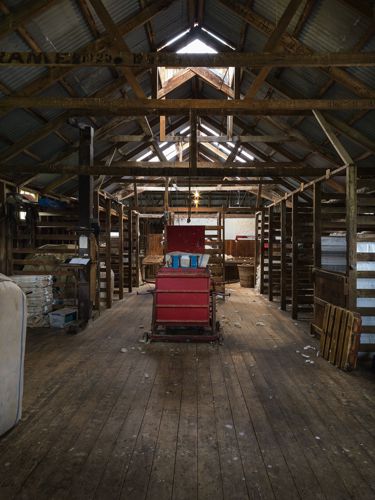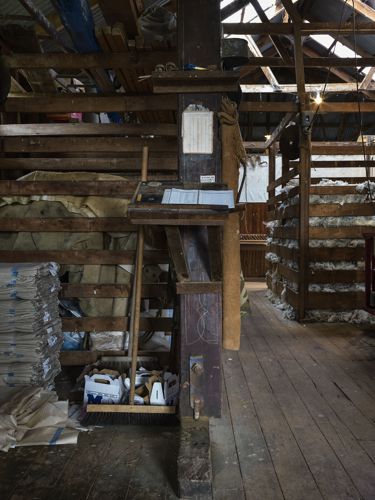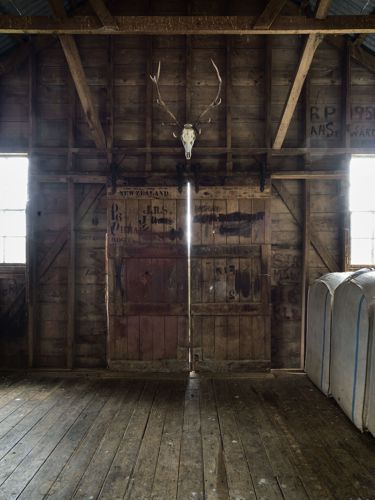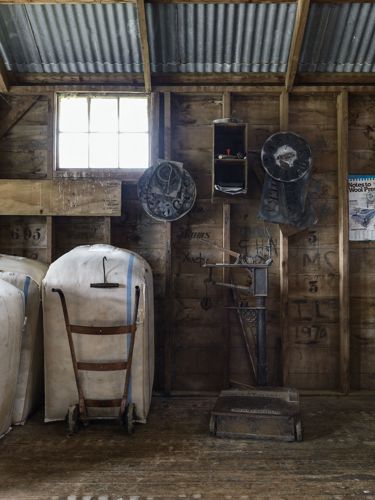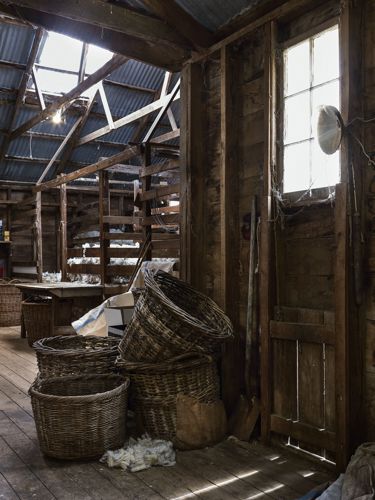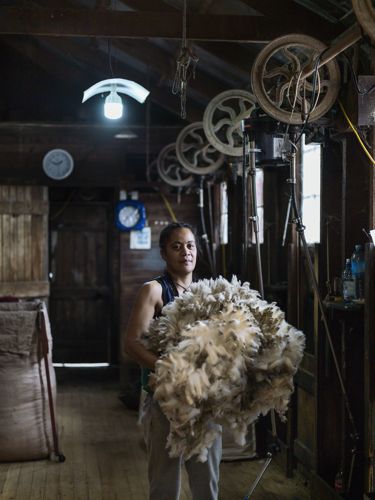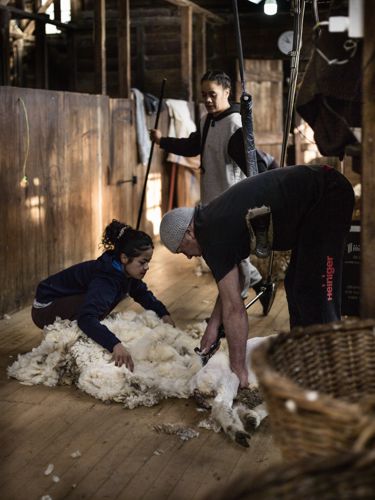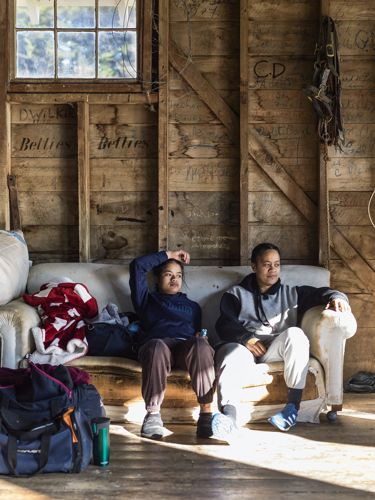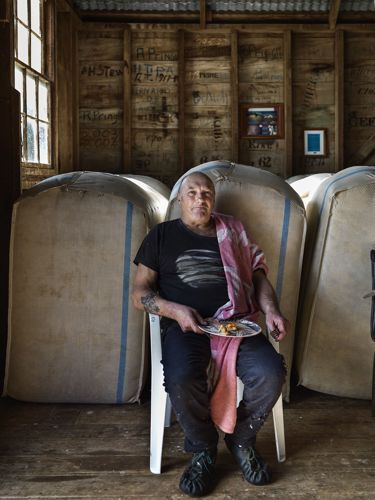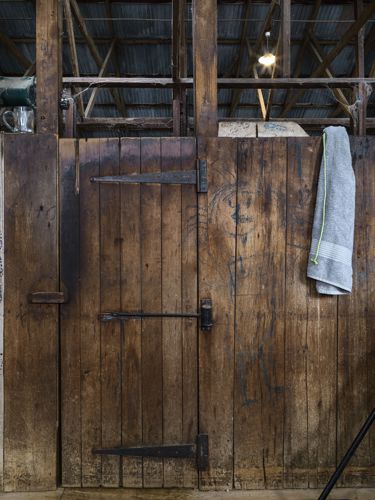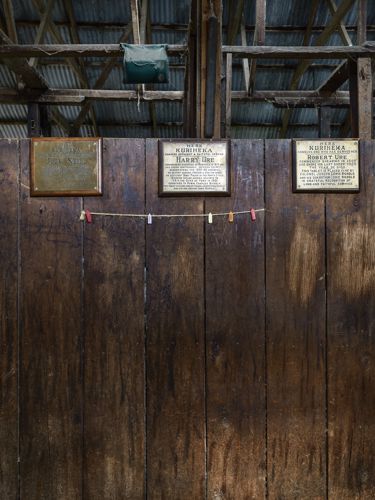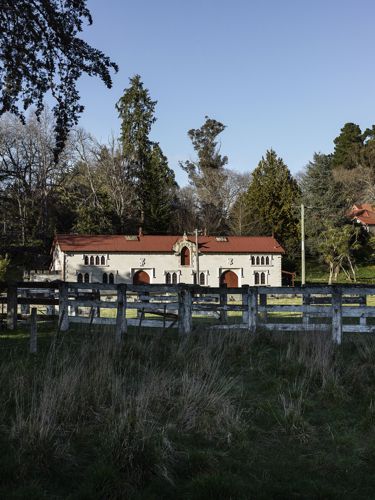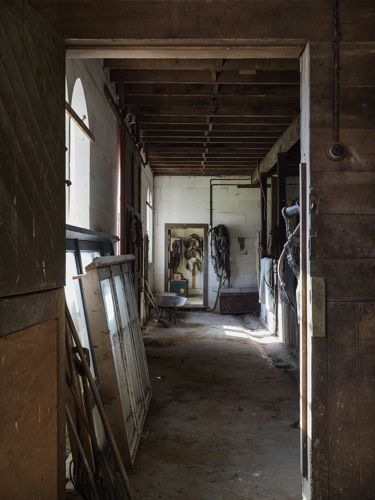Kuriheka
A winding country road from Maheno, southwest of Ōamaru in north Otago, leads to the magnificent Kuriheka woolshed. Kuriheka was originally part of the Otepopo run taken up by Charles Suisted in the late 1840s. From 1859 to 1885 its 12,500 hectares (31,000 acres) extended down to Shag Valley Station in the south and were owned by Fairfax Fenwick and his two brothers, who sold it to Joseph Cowie Nichols. It has remained in Nichols family ownership ever since.
Joseph Nichols was born in Tasmania, where his father, Charles, an astute businessman, worked for the large merchant firm Dalgety and Company. In 1869 Charles, his wife, Mary (née Cowie), and their family transferred to Dunedin, where he partnered with Frederick Dalgety to establish the stock and station agency Dalgety Nichols and Company, the forerunner to Dalgety and Company, which operated in New Zealand and Australia for over a century. The partnership ended when Charles was killed in a Cobb & Co coach accident on the Horse Range Road near Palmerston in 1878. The following year Mary and her nine children moved to England, and then to Dresden, Germany.
Joseph was educated at Cambridge University and went sheep farming in New South Wales. While he was working as a farm cadet at Benduck Station he met his future wife, Helen Ayre, the daughter of the station owner. He then moved back to New Zealand, where he bought Kuriheka and later married Helen. They would spend the next 40 years at Kuriheka developing the property.
In 1886 Joseph joined the Otago Mounted Rifles — the Nichols and Cowie coat of arms formed the centre of the Mounted Rifles’ cap badge — and rose through its ranks to become commanding officer of the Rifles, which used the field in front of the Kuriheka woolshed as a campground during training.
Joseph became the personal assistant to the governor-general of New Zealand, Lord Liverpool, in 1913 and commanded the Otago military district during the First World War. His collected weapons and military artefacts from around the world is held in the remarkable 32-room Kuriheka homestead, which sits behind large trees on a hill above the woolshed.
The woolshed, shearers’ quarters, stables, cookhouse and homestead drawing room were wedding gifts to Joseph and Helen from Joseph’s mother, Mary, and all bear the date 1889. Later generations of the Nichols family have continued the tradition of marking new buildings with the year in which they were built. Their commitment to preserving this history is evident, especially in the woolshed, where early equipment has been kept and, in many cases, is still used.
On the approach to the woolshed and below the homestead is the splendid Category 1 historic Ōamaru stone stables, an unusual two-storey building constructed from a plan brought back from Dresden by Mary Nichols. Its Germanic Gothic style is evident in the square head moulds above pointed arched doors and windows. A central dormer surrounding a wooden door on the second storey gave access to the loft for storing feed for Kuriheka’s horses, conveyed to the stalls below via a series of chutes.
Inside is a tack room and four wooden stalls for horses, including space for storing the
station carriage. The concrete floors are scored in a criss-cross pattern. The building’s cream limestone body contrasts with the vibrant red painted corrugated iron roof, and wooden doors. Above the two doors on the ground floor are stone shields embossed with arrowheads and fleur de lis from the Nichols and Cowie coat of arms.
The stables were home to New Zealand’s first Welsh mountain pony stud, established by Violet Nichols, the elder daughter of Joseph and Helen. She lived at Kuriheka for all her 80 years and developed the stud from 1946; her horses are the basis of New Zealand bloodlines today. When the Welsh Pony and Cob Society of New Zealand was founded in 1966 Violet was the inaugural president. The walls of the tack room are covered in her numerous awards.
Past the stone walls and entrance to the secluded homestead is an open field where the large 14-stand woolshed presides over a cluster of farm buildings. In keeping with the style of the stone buildings its exterior weatherboards were stuccoed and the flattened surface painted cream. The corrugated iron roof, doors, window frames and portholes are highlighted in red, and a raised roof lantern built to accommodate an early screw press is now a decorative feature topped with a weathervane. The shed sits on large Ōamaru stone block piles.
The woolshed is designed in the shape of a T, with a large central wool room in the long section. Bales are loaded from a raised platform in front of the main entrance, where double doors open into the wool room.
Between the rows of slatted wool bins on either side of the room is the unique Wool- Draulic Baler, a rarely encountered horizontal wool press made in the 1950s by Christchurch engineering firm C. W. F. Hamilton Ltd and designed by Bill Hamilton, owner of Irishman Creek Station and famous as the inventor of the jet boat engine. Although the long press takes up more space than a vertical press, it remains in good working order.
Birmingham-made W & T Avery cast iron platform scales and weights for recording the weight of wool bales are a common sight in historic woolsheds but are rarely used; they still function at Kuriheka. On the wall nearby is a collection of Kuriheka station stencils, some marked with the initials JCN above the station name.
Long shearing boards occupy two wings at the end of the wool room, and the seven shearing stands on each side are separated by a large wool table with wooden rollers. A rare sight these days in woolsheds are the well-oiled wicker wool baskets, which were traditionally filled with poor-quality and pieces of wool swept from the floor during shearing. Shearers at Kuriheka continue the same practice. The left wing accommodates a 1940s Lister two-stand portable shearing plant powered by a water-cooled petrol motor.
In 1916 a hydroelectric power generator came into use for electric light on the station; it
also drove independent shearing machines in the shed for crutching. The jet to the Pelton wheel was opened to 230 volts, which lit up six resistance bulbs. When the one-quarter-horsepower motors were turned on the lights would go out. This acted as a governor. When the motors were turned off the lights would turn back on.
These days only three stands operate in the shed’s right wing, close to the expert’s room, where a 3-brake horsepower Lister Electric Plant installed in the late 1950s powers the Lister shearing plant and grinder. The expert’s valve radio remains on the shelf in his back room. An imported Turkish sandstone grinder that once sharpened blade shears stands in front of the shed.
Behind the shearing board are the sheep pens, which can hold 600 sheep. Three memorial plaques in brass are secured to catching-pen doors opposite the board, honouring long-time employees of the station. Robert Ure began shearing in 1868 and shore his last sheep in 1929, the year he died. His brother Harry Ure started shearing at Kuriheka in 1874 and shore for 66 seasons until 1940. The plaque notes his expertise as an axeman, fencer and station hand.
A third plaque describes Jock Neill as an agricultural contractor, mechanic and farmer who began working at Kuriheka in 1934, at the age of 14. He bought and farmed an adjoining block, and carried out mechanical engineering jobs for Kuriheka until his death in 1998. The first two plaques were installed by Joseph Cowie Nichols and his son Arthur, and the third by Robin Nichols and his son Hugh, who is the current owner of Kuriheka.
To the right of the woolshed is the Category 2 historic two-storey limestone cookshop, whose design, with its square head moulds and a double shield above the door, reflects aspects of the stables. There were bunk beds upstairs for station workers and accommodation downstairs for the cook. Inside is a large common room with a dining table and an ‘Ideal Neo-Classic’ water-jacket wood burner at one end. The washroom has an original copper.
The smaller weatherboard and stucco building nearby, dated 1891, was shearers’ quarters, whose double bunk rooms accommodated up to 10 shearers. A gabled single storey dwelling with a verandah, it has a long front dining room with a large central table and coal range, fireplace and wood-fired bread oven at one end.
A row of sheds in a paddock behind the woolshed includes an implement shed, built recently to house an immaculate coal-powered traction engine made by Marshall, Sons & Co and used to haul wood. A 1916 limestone building housed a hydroelectric plant and an early refrigerator and freezer chamber insulated with cork. They were gravity fed with water piped down the hill from a reservoir behind the homestead. At the end is the site of an open sawmill that operated commercially from 1950 until the late 1960s, providing timber for Ōamaru. The sawmill is still fully functional and is used occasionally to cut timber for farm use.
Opposite the woolshed is a war memorial made of local stone and surrounded by British and German field guns brought back from the Western Front at the conclusion of hostilities in 1918. Erected in 1922, on its bronze roll of honour are the names of 83 men who had worked at Kuriheka and served during the war; 21 of them lost their lives. It was Joseph Nichols’ wish that the memorial serve as a permanent record and constant source of pride for future workers at Kuriheka. Included on the list are two of Joseph and Helen’s four sons — Joseph, who died in 1916, and Cyril, who died in 1918. They were both 22 years old.
On a hill above the Maheno turn-off to Kuriheka is St Andrew’s Memorial Church, built in 1939. Joseph Nichols and his brother Cyril funded the construction of the new church, whose stained glass windows on the west wall are memorials to their brother, Joseph’s two sons and a cousin who died in the First World War. The building was designed by Christchurch architects Cecil Wood and Richard Harman and the exterior is built of rock sourced from Kuriheka Station. The glazed shingle roof tiles were imported from Sydney. The beautiful limestone and wood interior has fine stone and wood carvings by Christchurch master carver Frederick Gurnsey, known for his work on the Bridge of Remembrance in Christchurch.
On his return from the First World War, Joseph’s son Arthur took over running the farm and his sister Violet maintained the homestead. In 1935 Joseph Nichols established the Kuriheka Trust, which placed the buildings and 186 hectares (460 acres) of freehold land into the Kuriheka Settlement Trust. Although his intention was to protect the property and the collection stored in the house, it has proven complicated in terms of ownership and funding for ongoing maintenance.
After Joseph’s death in 1954 Kurikeha was divided between his son Arthur and his grandsons David and Robin. David’s elder son Tim and his family occupied the homestead from 1984 until 2023, when Hugh and his family became the occupiers. Robin and Jenny Nichols’ three children have all been involved in the farming operation at various times, with Hugh recently taking over management of the farm. Hugh has worked on the farm since he left school and continues to stock Corriedales, a breed that has been on the station since 1885. The farm is now 2226 hectares (5500 acres) and runs 2500 ewes, 100 rams and 1000 hoggets, along with 350 cattle. Hugh farms with his son Taylor, who will be the fifth generation at Kuriheka.
Hugh is passionate about keeping the histories alive inside the Category 2 historic woolshed, as is his sister Bronwyn, who lives in Tīmaru but who comes to the farm to help with shearing. By safeguarding the original farm buildings and farming equipment they provide rare insights into early life on this once substantial country estate.
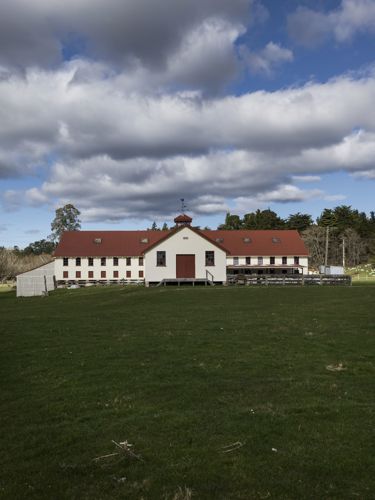
wool room.
